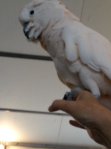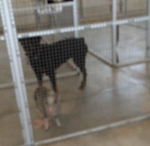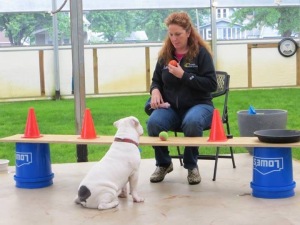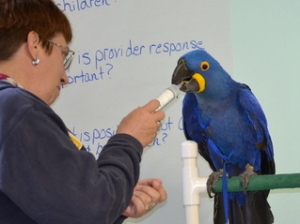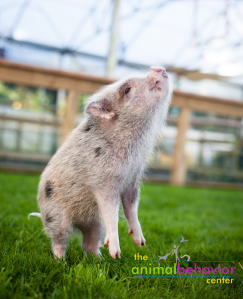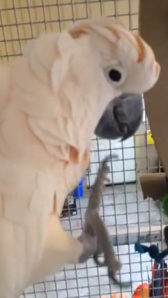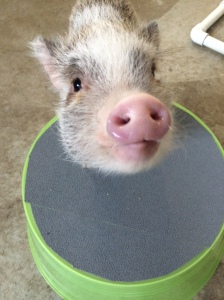We’ve Moved Our Blog
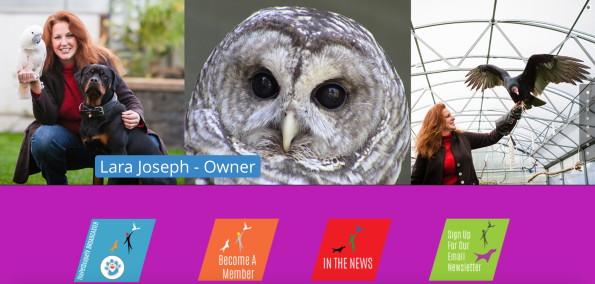 Hello Everyone!!!
Hello Everyone!!!
I wanted to share the new location of all of our new blog content. Click here to be directed to the new blog or sign up for our e-mail newsletter list to make sure you never miss an entry.
If you have a topic you would like to have addressed, let us know. We’d love to hear from you.
Sincerely,
Lara Joseph, Staff & Critters
An Everyday Training Example Here at The Animal Behavior Center
I took this video the other day while at the Center. This is everyday behavior, function,
and training. This is a loaded video and by that I mean, there is so much going on as far as training. I could easily use force but don’t want nor need to. I’m reinforcing behaviors I want to see increase and I wanted to write this blog post to point out all that is going on that could easily be overlooked. It’s the details which makes this whole video look so simple and smooth.
Here’s the link to the YouTube upload. For whatever reason, WordPress would not accept this video format. So, read the following and at the same time play the video and pause it as I walk you through it. Rewind and play again.
Rocky, the Moluccan cockatoo is on a playstation that hangs from the ceiling in the animal room. The playstation towers above our heads so we can easily walk underneath it and not have to walk into it. I ask Rocky to step onto my hand from way above my head. My cue is showing him my hand. I also ask him if he is ready, but I’m not sure he knows what this means. He steps onto my hand and you can hear me holding my breath as I am pulling him out and then down from the playstation. I’m holding my breath because I’m focusing on making sure his tail doesn’t bump the playstation. This is extremely important for me to pay attention to because most birds do not like their tail bumped while stepping off of perches. A tail bump could knock them forward and knock them off balance. I should have used a step ladder to get him down to make it all easier and less room for error. Since this video, I have started using the ladder.
The next step, I am struggling to make sure he does not lose his balance while I lower him to my level. I do not want to pair any part of him being off balance with stepping onto my hand, stepping off of this playstation, or being on me. If I begin pairing the above, I could easily and would likely punish the future behavior of him stepping onto me off of this playstation or any perch.
As I am walking him back to his cage, I am trying to identify a reinforcer. A reinforcer for what? For a few things. Based on his body language (fluffy beak, relaxed eyes, loose feather placement) I am guessing that attention might be a reinforcer. I am looking for a reinforcer to make sure I withhold while on my arm because I’m getting ready to ask him to step up into his cage and off of me. I don’t want to deliver a valuable reinforcer at this point while he is on my arm because I need to deliver it when he gives me the behavior of stepping off of my arm.
After I walk into Rocky’s cage, I turn to look where Milo the pig is standing. He’s standing on his X. The X is for him to stand on or near while cage doors are open. The importance of this segment is the bridge. A bridge is a sound or signal that tells the animal that particular behavior is what is earning you your reinforcer. Bridging is so extremely important and you can see its use here. I turn and look at him and deliver the bridge, which is the word ‘good’. I deliver the bridge and walk away because I need to get Rocky to step off of my hand before I can deliver a reinforcer for Milo, because I don’t have an extra hand to deliver it. I have a bird on one arm and a camera in the other. The importance of the bridge, once the animal understands it, is that Milo knows the reinforcer is coming.
I walk Rocky back to his perch and cue him to step off of me. He doesn’t so I
show him the cue for petting with the finger movement from the fingers on the arm he is standing on. I am luring him. The lure is my finger movement. I’m showing him what he will get if he steps off of me. I then give a small whistle that I usually make when I’m petting him.
I turn and look to see where the mammals are. They are right where I want them to be so I bridge again to help keep them there. I then turn again and put the camera in front of the perch where I want Rocky to step up. I give him a small pet on the head as an additional lure and he steps off of me immediately. I move in and deliver the reinforcer which is the head scratch. I deliver in a large enough amount to keep him there while I turn and bridge and reinforce awesome behaviors happening behind me with the mammals.
The door to the cage is wide open and yet I have two well trained animals not entering and staying near the target, which is the X on the floor. I grab some of Rocky’s food from his dish and reinforce the mammals. This is where it gets tricky and I bet most people may not have caught this. I am dropping the food into Quincy, the Rottweiler’s mouth. I drop because I don’t want mammal saliva on my hands which could cross contaminate from mammal to bird. Quincy’s food drops to the floor next to the pig. The pig is trained to not rush for food when dropped on the floor because if he does there could be a Rottweiler and a pig charging after the same piece of food. Quincy and Levi (deaf bulldog) are also trained to not reach for food that wasn’t dropped for them. Milo clearly looks at the food and remains in position. There were several previous training sessions to train this and for this particular purpose.
Length of time delivering a reinforcer may have an impact on the reinforcement. I asked Rocky to step off of me and I petted for a few seconds and walked away. I guarantee you that if I asked him to step off again for a small period of time in preening his feathers, he wouldn’t step off of me again. It isn’t worth it to him. This is why I turn and walk back into the cage, ask him if I can pet giving him the choice and empowering him, and then he moves in to accept more reinforcement.
There was no need to force any animal to do anything. I didn’t have to stick a leg out to keep the dog or the pig out of the cage. All behavior was willing given to me because I have a history of delivering the animal’s reinforcers when they give me a behavior I request. Not a command….a request. A pleasant way for all to live and reasons for everyone to want to continue giving desirable and requested behaviors. 😉 Happy Living! Happy Training!
Deafness Is Not A Disability
Levi is our deaf education bulldog. He was surrendered to us by his breeder on New Year’s Eve of 2013. I had every intention of training him for two weeks and finding him a new home. We had several people waiting in line to adopt him. Along with the waiting list we also had an over-abundance of followers on Facebook asking us why we would not keep him and help teach people how to work with deaf animals. Well, that over-abundance of people got their wish. A year and a half later, he is a major educator here at The Animal Behavior Center, to me and may owners of deaf dogs and other deaf animals.
He is fun to train. He has taught me so much about observation, being a better reader of body language, and being fluent in my communication skills with him. Now every animal here is trained and communicated with through sign language. The parrots, the vulture, the fish, the pigs, the other dog that is not deaf all are trained through visual communication because of Levi. He proudly walks me on the other end of his leash. His body smiles and he holds his head high when we walk. I love this for him and I can’t wipe the smile from my face when walking him. I’m a huge promoter of empowering animals. Did I already say that I love this for him?
I had a conversation with a colleague today. We were talking about the variety of animals I train through Applied Behavior Analysis and positive reinforcement training. When I started talking about Levi, I mentioned he has been fun for me to train and how well of a clear line of communication we have with each other. I told her “His deafness is not a disability.” There is nothing his lack of hearing is contributing to any form of disability. He is easier for me to train than my dog that can hear! His deafness just means he cannot hear. His deafness has caused me to be a better trainer and communicator. Living with and training Levi has caused me to expand on being creative.
Levi’s deafness has taught me to be able to train animals through glass. By this I mean, I can now look out a window and communicate with the dogs, pigs, birds, etc through signing through the glass. This is so cool! Most of my training sessions with the animals are silent. There are no verbal bridges. They are visual. Many times I go through a training session without any sound from me except for an occasional sigh when I am trying to figure out how to communicate better with the animal. I thank Levi for introducing me to his world. His world is a fun place for me to be.
For more information on training a deaf dog: For the past year and a half, I have recorded most of my training with Levi. I am using these videos in the webinars I give on training deaf dogs. I also post behavior and training videos and tips on The Animal Behavior Center’s Facebook page. We are also developing deaf dog training classes, which we will be recording to share with people who care for deaf dogs nationally and internationally. If you have questions, please leave a comment and I will respond as soon as I can.
Recall, shaping, and chaining behaviors with Levi.
Adding Another Animal Behavior & Training Workshop to July of 2015
Our June 2015 Workshop sold out in January before we even had time to advertise it. A waiting list already started forming for
June 2016. Due to this demand and current projects underway here at The Animal Behavior Center, we are contemplating adding another workshop this year for the weekend of July 11th, 12th, & 13th, 2015. The format will be the same described on our website with the third day as optional. We are starting a waiting list of people who may be interested if we offer this workshop in July of this year. Take a look at our June 2015 Workshop for details of what the workshop contains. If we get enough interest, we will schedule the workshop and begin taking registrations.
We sent out an e-mail notification to our e-mail newsletter list last night and have received a waiting list currently developing. If all people attend that have signed up to be notified, first come first serve, this workshop will only have a few seats left before being sold out.
If you are interested in being put on the waiting list for the July 2015 Workshop, please e-mail us at the address at the bottom of the home page on our website with notification that you are interested. If we receive enough interest, we will notify all on the notification list in the order they e-mailed us with first option to reserve your seat before we notify the public, if seats are still available.
Once again, and as always, we here at The Animal Behavior Center are very appreciative of your overwhelming and on-going support. Please do not hesitate in letting us know if you have any questions.
Sincerely,
Lara Joseph/Owner of The Animal Behavior Center
Attention As A Reinforcer
One of the strongest and most common reinforcers is attention, yet it is the one reinforcer I see used the least or misused the most. If that statement has you thinking, it should because it’s a powerful one. I will make several upcoming posts here on reinforcers. For now, following is a clip of me using an obvious reinforcer… attention, properly identifying it, and increasing its intensity once I know it is a valued reinforcer. I know it is a valued reinforcer because I am watching my dog’s reaction to it. Another important point, it is always the animal that decides the reinforcer. It is up to us to deliver effectively for desired behaviors.
In the following video, I am waiting for Quincy, our Rottweiler to be doing any other behavior besides focusing on me. I decide to call her to me while she is comfortably lying down. Because she responded to me so quickly, I need to make sure I deliver a strong reinforcer if I want this behavior to maintain or increase in the future. I deliver my attention as a consequence (intended reinforcer) and then I increase that reinforcer by kissing her, and by continuing to deliver the attention. This is an obvious and highly valued reinforcer of hers.
Effective use of reinforcers relies heavily upon being able to properly identify them. What is your animal looking at? What is it playing with? What is it eating? What prompts it to stand up and walk or fly across the room? When you can answer these questions, you have properly identified potential future reinforcers.
Watch our Facebook page, The Animal Behavior Center, for frequent behavior and training videos and clips. All of our webinars are in the process of being recorded. We have one specifically on Reinforcers, Reinforcement, & Their Use. Even more exciting, we have some very exciting news you can be a part of. Stay tuned. It is my pleasure to be able to share all of what is becoming of The Animal Behavior Center, with you. ~Lara Joseph
Preparing our animals for success with social encounters and new environments
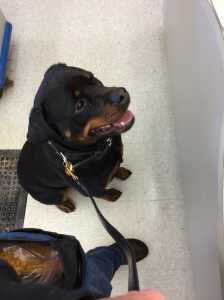
Quincy sitting at the checkout line of a pet store. She received both treats and attention as a reinforcer for this desired behavior.
Does the undesired behavior of your animals prevent you from taking them on social outings or to new environments? This can be changed. So many times I see people restricting themselves from leaving the house or taking animals with them on outings because they don’t feel they can keep their animal under control or keep from being embarrassed about their behavior. This makes me sad for the animal and for the person both. I love seeing happy animals and I love seeing people who are proud of their animals, especially in public. Let me share with you an experience I had yesterday with my dog, Quincy.
We’ve been pretty busy here at the center through the winter with behavior consults, on-line classes, consultations, etc. Many of these consultations are for behavior concerns people want to change now so they can take their animals out for socialization, therapy, etc when the weather warms. I was talking to the other trainer here at the center yesterday and letting her know I wanted to get some of our animals out for more socialization through the winter. There are plenty of places you can take your animals for exposure to people and changing surroundings during the cold months. Yesterday I picked a pet store.
Quincy hasn’t been to a pet store in months. I was careful in picking the store, the time of day, and the weather. I wanted to set Quincy up for success for the behavior I was expecting from her, being able to reinforce the desired behavior, and not pushing her past her comfort level. This began with me getting her out of the back of the Jeep. There are a lot of scents, visual enrichment and distractions, sounds, animals, and potential for people wanting to interact with her. For a dog that hasn’t been to a pet store in months, this is a lot of information for her to take in and be comfortable with. I picked an outing at Quincy’s comfort level and I chose to go on a day that was snowing heavily, early afternoon, and during the week. I picked this day and this time in hopes that my encounters with other people and animals would be low because I need to control as much of Quincy’s environment as possible to make sure this outing is a success. It was but I also recognized behaviors that needed addressing and training.
We got out of the Jeep and immediately saw a woman with a puppy. Quincy gave a small bark. I asked her to sit as the puppy approached. That puppy’s future is just as important to me as Quincy’s. Quincy is a big dog and not all puppies are comfortable with big dogs approaching them. I don’t know how the woman is training her dog and it is not fair for me to decide if it is ok for us to approach her dog. The woman did not ask me if it was ok for an encounter so I reinforced Quincy for sitting until the puppy got in the car.
Within seconds of walking into the store, I could tell this was the jackpot of sensory information for Quincy. She kept stopping and smelling everything. I let her continue to sniff when we entered the store. She is a dog after all and this is enrichment and information to them. Keeping in mind this was her first time in a pet store in months, I relaxed the criteria of what I was asking from her. As we continued to walk through the store she began pulling on the leash. Ahhh, I can work with this. Why is she pulling on the leash? Because she wants to get to the next scent. I identified the reinforcer behind a behavior I did not want to see increase so I used it to our advantage in training. When she pulled, nothing happened on my end. When she relaxed on the leash and looked back at me, I told her “Good” and motioned for her to go and get the scent. As I continued to do this she understood that she was going to be able smell the goodies and that was contingent on a loose leash.
We saw another dog that surprised us walking around an isle. I immediately saw Quincy’s ears rise. The dog was galloping towards us. The person on the other end of the leash was looking at the toys in the isle and not at us or his dog. Since he wasn’t watching what his dog was watching, I redirected Quincy’s attention by asking her to follow me and we walked quickly toward the rabbit isle, an isle I thought the person might be less likely to walk down. I reinforced the heck out of the behavior of Quincy giving me the behavior I asked. I reinforced with an exaggerated “Good girl” and kneeling down in front of her for a neck scratch and a kiss.
After about five minutes we headed to the checkout counter. This outing was successful so far so I wanted to keep it short. There was no one in front of us which was what I was hoping for by picking a day where I thought people were less likely to visit a store. Within a minute someone walked up behind us. She asked if she could pet Quincy and I kindly told her, “Please don’t” and then explained to her my intention. I told her Quincy hadn’t been in a pet store in a while and this was a training exercise for her. I told the woman that I didn’t want Quincy to learn that every time she sees a person that she can run up to them expecting to be petted. The woman clearly understood. As Quincy sat next to me during checkout, I put her goodies in a bag and turned to the woman and asked if she was ok petting Quincy after I told Quincy to go greet her. The woman was obviously happy to do so. Before I told Quincy to go greet the woman, I told her “Good” gave her a treat and asked her if she wanted to go greet the woman. This was something I could tell Quincy clearly wanted to do, so I used it as a reinforcer for her behavior of sitting next to me until I was finished at the check-out line. I was very proud of Quincy. I saw some things we needed to work on so I knew we could work on these behaviors after we returned to the center.
On the way out the door I saw the display isle. I knew Quincy would want to sniff it so I let her sniff the base of it as a reinforcer for walking next to me on a loose leash until we got there. I told her to “Go ahead” as I motioned to the isle.
Dogs have such a great sense of smell. To be in a pet store and not be able to gather information from those smells would be cruel for me to ask. Quincy and I make a team. I enjoy spending time with her and I want her to enjoy her outings with me. Our training makes it beneficial to both of us. If you want to learn more about working with behavior concerns or training desired behaviors you and your animal will look forward to, take a look at our Webinars and our On-Line Consultations.
Here is a video I think might be helpful to people wanting to better understand what your dog gathers through its nose and how it impacts behavior and information gathering. Enjoy and as always, contact us if you have questions.
How do dogs “see” with their noses? by Alexandra Horowitz: https://www.youtube.com/watch?v=p7fXa2Occ_U&feature=youtu.be
When Does Training Cease?
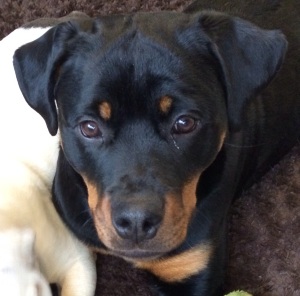
Training is the best form of communication we have with our animals. If an animal is still observing or hearing elements in its environment, training is still happening. Do you understand what you are training?
What is training anyway? Training is our primary form of communication with the animal(s) in our care. We are always training, the questions is….What are we training? If our animals can see or hear us, training is happening.
When our training plans take an unexpected turn and the consequences are not what we intended, this doesn’t mean the training of the animal has ceased. Quite the contrary. If our animals are reacting or learning from our mistakes, they are learning from our lack of preparation. Once an animal learns a behavior, desired or undesired, it has experienced it. It cannot ‘un-experience’ the consequence of this interaction. The training has not stopped. The training is continuing, it is just not the training or communication we want. This is when undesired behaviors are being trained or communicated.
When force is used to try to control behavior, what message are we communicating to the animal in which we are trying to build a relationship? If force is being used to communicate a message to the animal, coercion is being used. Coercion may work but not without its side effects. Coercion is “Do it or else!” Coercion has many side effects and reinforcing increased aggression from the animal is a powerful one and so is learned self helplessness. Is increase aggression what you want from your animal? Is a cowering animal what you want portrayed as your relationship with the animal in your care?
When our training plans don’t have the outcomes we want, this doesn’t mean the learning from the animal has ceased. That animal is learning how to respond in future situations. As mentioned before, “What are we training?”
For more information visit TheAnimalBehaviorCenter.com.
Reinforcing Behavior With Attention & Petting
One of the hardest things I hear and observe animals owners and caretakers struggling with is identifying and using reinforcers. Reinforcers are all around us all day. It is the individual that decides their reinforcer. A reinforcer is something delivered after a behavior that causes the future rate of that behavior to maintain or increase. Reinforcers can change in a matter of seconds and believe it or not, so many reinforcers are not food or treats.
My Reinforcer For Training
I was recently given the opportunity to give an extremely brief presentation on the type of work I do. It was optional for me to bring an animal. Of course I chose to do so. It’s one thing to talk about the work I do, and it’s another and so powerful to see the work in action. I chose to take Milo, the micro-mini pig that comes here to the Center for training.
Milo has only been in one presentation I have given and that was about a month ago to a group of sixty people and that was here at the Center. Milo is very familiar with everything here at the Center. Before this presentation on Tuesday night, Milo has never been in a presentation off-site. The pressure was on. Well, it was on for me and I did my hardest to make sure any nervousness was not transferred through me to Milo.
The night before the presentation I began our training. We tried a few different things. Some behaviors were taking more time to train than I had. We settled on a few behaviors and practiced them, their sequence, and what I was going to say the day of the presentation.
That evening we were on. The event was in a hotel conference room. I brought Milo into the hotel and practiced a few behaviors in the hallway prior to the event. He was hesitant on one of the behaviors and then I observed him stop giving another I had trained. Not what I wanted to see but more important, I didn’t want to push him past his comfort level. It wasn’t worth it and I definitely didn’t want that feeling paired with his first presentation.
A few minutes before our presentation we practiced again before we walked in. He was spot on. The doors opened and I asked Milo to step up and in my arms he went while I carried him in the conference room. I gave my presentation fairly smoothly and the best part of all, Milo did every behavior I requested of him without hesitation. I was so proud of him and I was extremely happy as I thanked everyone and walked off the stage with Milo. When I walked out of the conference room, I was on cloud nine. This was a new environment for him and this was a group of people I was nervous about presenting. Milo and I were a team on that stage. He complemented me and hopefully he found that I complemented him. We won the competition that evening.
An hour later we were in the car and on our way home. His crate was right behind the driver’s seat. He was grunting his comfort grunts. I laughed and glanced back at him. His head was poking out of his blanket and looking at me. I put my fingers in his crate as I drove and he rested his head in my hand. What an award that was to me. No competition could give me a better prize than that.
I walked him in the house and he followed willingly and without hesitation. That night I chose to pick him up and set him on
my chest as I lied on the couch. His feet tucked under his tiny body and that is where he fell asleep. What a connection we made with each other that evening. That is the connection made through the type of training I do and behavior I study. Whether we won the competition that night or not, I won regardless. Thank you Milo. Thank you for that experience.
Teach Your Bird to Forage
Let me help show you a great way to keep your birds occupied while you are at work all day or away for long periods if time. Foraging is the behavior of looking for and attaining food or treats.
Foraging is a learned behavior of all birds who live in the wild and it occupies a major portion of their day. Let me show you how to replicate this behavior in your birds’ cages and environments. The birds in my care look forward to being returned to their cages for the opportunity to forage.
Join me, Lara Joseph, owner of The Animal Behavior Center tomorrow at 7:30pm EST for a live webinar that I will be hosting to an audience of limited seating. I will show you step-by-step instructions through video, live demonstrations, and photos I have taken with the foraging toys I have designed to teach my own birds how to forage.
This webinar will be an hour and a half in length. For $30 you can reserve your seat by clicking on the following link. Once I receive your payment, I will e-mail you a link to download and join me on your computer.
Click here to reserve your seat. I look forward to talking with you tomorrow in this webinar.
